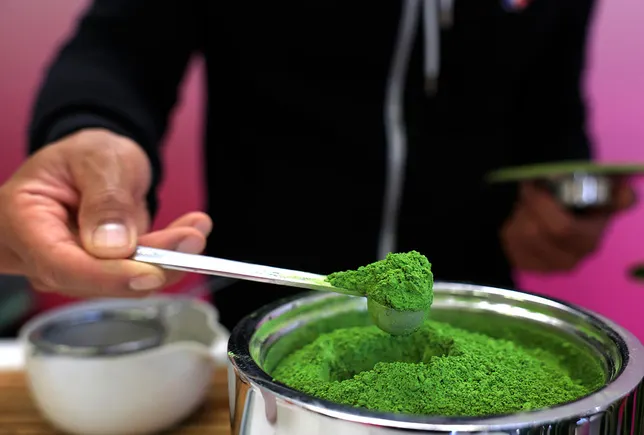Matcha Madness: The Rise and Fall of Japan’s Green Tea Craze
Matcha, the powdered green tea that has taken social media by storm, is facing unprecedented supply shortages as demand skyrockets. Online scalpers are now capitalizing on the craze, selling the coveted ingredient at inflated prices.
Originally used in traditional Japanese tea ceremonies, matcha has now found its way into a variety of modern creations, from lattes to desserts. Marketed as a “clean caffeine” alternative to coffee, its vibrant green hue has captured the attention of younger consumers seeking visually appealing food and drinks for platforms like TikTok and Instagram.
The matcha market reached $478.8 million in 2024 and is projected to hit $762.6 million by 2030, according to Grand View Research. Retail sales of matcha powder have surged by 86% in the past three years, as reported by NeilsenIQ data cited by the Associated Press.
However, the surge in matcha’s popularity has put a strain on Japanese farmers, who have historically been the primary producers of the tea. Factors such as extreme weather conditions, an aging farming population, and the meticulous production process required for high-quality matcha have led to severe supply shortages and soaring prices.
Peter Goggi, president of the USA Tea Council, explained, “Matcha only represents about 7% of total tea production in Japan. The processing of matcha is precise and demands specific equipment and techniques.”
According to the International Tea Committee, matcha is prepared from Tencha, a shade-grown leaf highly vulnerable to climate change. Japan’s recent heatwaves and droughts have resulted in smaller-than-expected harvests, exacerbating the matcha shortage.
Tencha trading prices in Kyoto surged by 265% between 2024 and 2025, with the ITC citing data from JA Kyoto. The 15% tariff imposed by the Trump administration on Japanese imports has further driven up prices in the U.S., leading to extended wait times of up to six months for matcha products.
The scarcity of matcha has given rise to a new issue – scalpers. Exploiting the high demand, unauthorized resellers are either selling matcha at premium prices or flooding the market with substandard products.
David Lavecchia, co-founder of Tezumi, a U.S.-based tea seller, expressed his surprise, saying, “It’s surreal to see matcha being scalped. This wasn’t something we would have anticipated a few years ago.”
Many matcha suppliers have imposed purchase limits to combat scalping. Marukyu Koyamaen, a renowned Kyoto matcha producer, has published a growing list of unauthorized resellers, many of whom operate through social media channels.
With the surge in demand, many Japanese farmers have switched from producing other teas to focusing on matcha. Additionally, countries like China, Kenya, and India are ramping up their matcha production to meet the market demand.
Despite these efforts, it takes five years after planting a new tree before farmers can harvest matcha, as noted by Ippodo Tea. Ippodo Tea has raised the prices of its top-tier Ummon matcha by 53% due to the supply constraints.
While increasing matcha production from other regions may help meet the demand for lower-grade matcha used in beverages and desserts, Lavecchia emphasized the importance of preserving the high-quality matcha traditionally reserved for ceremonial use.
Goggi of the USA Tea Council pointed out that consumers have plenty of alternatives to matcha, as it is essentially ground green tea leaves sourced from the Camellia sinensis plant, which also produces black, oolong, white, and dark teas.
He cautioned against getting caught up in the matcha hype, saying, “While matcha is beneficial, it’s not inherently superior to other types of tea like green or black tea.”

